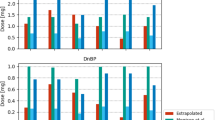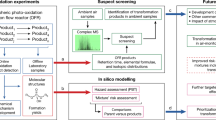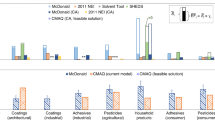Abstract
Estimates of human exposure to semi-volatile organic compounds (SVOCs) such as phthalates, phthalate alternatives, and some per- and polyfluoroalkyl substances (PFAS) are required for the risk-based evaluation of chemicals. Recently, a modular mechanistic modeling framework to rapidly predict SVOC emission and partitioning in indoor environments has been presented, in which several mechanistically consistent source emission categories (SECs) were identified. However, not all SECs have well-developed emission models. In addition, data on model parameters are missing even for frequently studied SVOCs. These knowledge gaps impede the comprehensive prediction of the fate of SVOCs indoors. In this paper, sets of high-priority phthalates, phthalate alternatives, and PFAS were identified based on chemical occurrence indoors and additional selection criteria. These high-priority chemicals served as the basis for exploring model parameter availability for existing indoor SVOC emission and partitioning models. The results reveal that additional experimental and modeling work is needed to fully understand the behavior of SVOCs indoors and to predict exposures with greater confidence and lower uncertainty. Modeling approaches to fill some of the identified gaps are proposed. The prioritized sets of chemicals and proposed new modeling approaches will help guide future research. The inclusion of polar phases in the framework will further expand its applicability and scope.
Impact statement
This paper compiles data on high-priority chemicals commonly found indoors and information on the availability of applicable models and model parameters to predict emission, partitioning, and subsequent exposure to these chemicals. Modeling approaches for a selection of the missing SECs (source emission categories) are proposed, to illustrate the path forward. The comprehensive data set helps inform researchers, exposure assessors, and policy makers to better understand the state of the science regarding modeling of indoor exposure to semi-volatile organic compounds (SVOCs) and per- and polyfluoroalkyl substances (PFAS).
This is a preview of subscription content, access via your institution
Access options
Subscribe to this journal
Receive 6 print issues and online access
$259.00 per year
only $43.17 per issue
Buy this article
- Purchase on Springer Link
- Instant access to full article PDF
Prices may be subject to local taxes which are calculated during checkout


Similar content being viewed by others
Data availability
Search terms used for Google Scholar search engines are documented in Table S1 in the SI. Further details of the literature review of existing SVOC emission and partitioning models, as well as the equations and a full list of references, can be found in the SI. The complete versions of the lists of high-priority compounds can be found in a separate Excel spreadsheet in the SI.
References
Kapraun DF, Wambaugh JF, Ring CL, Tornero-Velez R. Woodrow setzer R A method for identifying prevalent chemical combinations in the U.S. population. Environ Health Perspect. 2017;125:087017.
Salthammer T, Zhang Y, Mo J, Koch HM, Weschler CJ. Assessing human exposure to organic pollutants in the indoor environment. Angew Chem Int Ed. 2018;57:12228–63.
Egeghy PP, Sheldon LS, Isaacs KK, Özkaynak H, Goldsmith M-R, Wambaugh JF, et al. Computational exposure science: An emerging discipline to support 21st-Century risk assessment. Environ Health Perspect. 2016;124:697–702.
OECD. Internationally harmonised functional, product and article use categories, 2017.
NASEM. Using 21st-century science to improve risk-related evaluations: Washington, DC, 2017.
Cohen Hubal EA, Wetmore BA, Wambaugh JF, El-Masri H, Sobus JR, Bahadori T. Advancing internal exposure and physiologically-based toxicokinetic modeling for 21st-century risk assessments. J Expo Sci Environ Epidemiol. 2019;29:11–20.
Thomas RS, Bahadori T, Buckley TJ, Cowden J, Deisenroth C, Dionisio KL, et al. The next generation blueprint of computational toxicology at the U.S. environmental protection agency. Toxicol Sci. 2019;169:317–32.
Krewski D, Andersen ME, Tyshenko MG, Krishnan K, Hartung T, Boekelheide K, et al. Toxicity testing in the 21st century: Progress in the past decade and future perspectives. Arch Toxicol. 2020;94:1–58.
Anastas P, Teichman K, Cohen Hubal E. Ensuring the safety of chemicals. J Expo Sci Environ Epidemiol. 2010;20:395–6.
Eichler CMA, Cohen Hubal EA, Xu Y, Cao J, Bi C, Weschler CJ, et al. Assessing human exposure to SVOCs in materials, products and articles: A modular mechanistic framework. Environ Sci Technol. 2021;55:25–43.
Wang C, Collins DB, Arata C, Goldstein AH, Mattila JM, Farmer DK, et al. Surface reservoirs dominate dynamic gas-surface partitioning of many indoor air constituents. Sci Adv. 2020;6:1–11.
Nazaroff WW, Weschler CJ. Indoor acids and bases. Indoor Air 2020; just accepted.
ASTM. Standard Guide for Selecting Volatile Organic Compounds (VOCs) and Semi-Volatile Organic Compounds (SVOCs) Emission Testing Methods to Determine Emission Parameters for Modeling of Indoor Environments. In: ASTM D8141-17. West Conshohocken, PA: ASTM International, 2017.
ISO. 16000-6 Indoor air -- Part 6: Determination of volatile organic compounds in indoor and test chamber air by active sampling on Tenax TA sorbent, thermal desorption and gas chromatography using MS or MS-FID. In: 1304020 - Ambient atmospheres: International Organization for Standardization, 2011.
WHO. Indoor air quality: Organic pollutants. World Health Organization: Copenhagen, NL, 1989.
Weschler CJ, Salthammer T, Fromme H. Partitioning of phthalates among the gas phase, airborne particles and settled dust in indoor environments. Atmos Environ. 2008;42:1449–60.
Donahue NM, Kroll JH, Pandis SN, Robinson AL. A two-dimensional volatility basis set – Part 2: Diagnostics of organic-aerosol evolution. Atmos Chem Phys. 2012;12:615–34.
Liu Z, Little JC. Semivolatile organic compounds (SVOCs): phthalates and flame retardants. In: Pacheco-Torgal F, Jalali S, Fucic A (eds). Toxicity of Building Material; https://doi.org/10.1016/B978-0-85709-122-2.50017-6. Woodhead Publishing Limited: Philadelphia, PA, 2012, pp 122–37.
Weschler CJ. Changes in indoor pollutants since the 1950s. Atmos Environ. 2009;43:153–69.
Weschler CJ, Nazaroff WW. Semivolatile organic compounds in indoor environments. Atmos Environ. 2008;42:9018–40.
Weschler CJ, Nazaroff WW. Growth of organic films on indoor surfaces. Indoor Air. 2017;27:1101–12.
Tang X, Misztal PK, Nazaroff WW, Goldstein AH. Siloxanes are the most abundant volatile organic compound emitted from engineering students in a classroom. Environ Sci Techol Lett. 2015;2:303–7.
Duncan SM, Sexton KG, Turpin BJ. Oxygenated VOCs, aqueous chemistry, and potential impacts on residential indoor air composition. Indoor Air. 2018;28:198–212.
Adams RI, Lymperopoulou DS, Misztal PK, De Cassia Pessotti R, Behie SW, Tian Y, et al. Microbes and associated soluble and volatile chemicals on periodically wet household surfaces. Microbiome. 2017;5:1–16.
Farmer DK, Vance ME, Abbatt JPD, Abeleira A, Alves MR, Arata C et al. Overview of HOMEChem: House observations of microbial and environmental chemistry. Environ Sci: Process Impacts 2019;21:1280–1300.
Hodas N, Loh M, Shin H-M, Li D, Bennett D, McKone TE, et al. Indoor inhalation intake fractions of fine particulate matter: Review of influencing factors. Indoor Air. 2016;26:836–56.
Hodas N, Turpin BJ. Shifts in the gas-particle partitioning of ambient organics with transport into the indoor environment. Aerosol Sci Technol. 2014;48:271–81.
Xu Y, Zhang J. Understanding SVOCs. ASHRAE J. 2011;53:121–25.
Zhang X, Arnot JA, Wania F. Model for screening-level assessment of near-field human exposure to neutral organic chemicals released indoors. Environ Sci Technol. 2014;48:12312–9.
Li L, Arnot JA, Wania F. How are humans exposed to organic chemicals released to indoor air? Environ Sci Technol. 2019;53:11276–84.
Lakey PSJ, Eichler CMA, Wang C, Little JC, Shiraiwa M. Kinetic multi-layer model of film formation, growth, and chemistry (KM-FILM): Boundary layer processes, multi-layer adsorption, bulk diffusion, and heterogeneous reactions. Indoor Air 2021; Early View.
Jaakkola JJ, Parise H, Kislitsin V, Lebedeva NI, Spengler JD. Asthma, wheezing, and allergies in Russian schoolchildren in relation to new surface materials in the home. Am J Public Health. 2004;94:560–2.
Matsumoto M, Hirata-Koizumi M, Ema M. Potential adverse effects of phthalic acid esters on human health: A review of recent studies on reproduction. Regul Toxicol Pharm. 2008;50:37–49.
Schossler P, Schripp T, Salthammer T, Bahadir M. Beyond phthalates: Gas phase concentrations and modeled gas/particle distribution of modern plasticizers. Sci Total Environ. 2011;409:4031–8.
Eichler CMA, Little JCA. Framework to model exposure to Per- and Polyfluoroalkyl substances in indoor environments. Environ Sci: Process Impacts. 2020;22:500–11.
Sunderland EM, Hu XC, Dassuncao C, Tokranov AK, Wagner CC, Allen JG. A review of the pathways of human exposure to poly- and perfluoroalkyl substances (PFASs) and present understanding of health effects. J Expo Sci Environ Epidemiol. 2019;29:131–47.
Sznajder-Katarzynska K, Surma M, Cieslik IA. Review of Perfluoroalkyl Acids (PFAAs) in terms of sources, applications, human exposure, dietary intake, toxicity, legal regulation, and methods of determination. J Chem. 2019;2019:1–20.
Wang Z, DeWitt JC, Higgins CP, Cousins ITA. Never-Ending Story of Per- and Polyfluoroalkyl Substances (PFASs)? Environ Sci Technol. 2017;51:2508–18.
Bălan SA, Mathrani VC, Guo DF, Algazi AM. Regulating PFAS as a chemical class under the California safer consumer products program. Environ Health Perspect. 2021;129:025001.
USEPA. Phthalates Action Plan. U.S. Environmental Protection Agency 2012.
OECD. Prioritisation of chemicals using the integrated approaches for testing and assessment (IATA)-based ecological risk classification. Organisation for Economic Co-operation and Development, 2018.
USEPA. Drinking Water Contaminant Candidate List (CCL) and Regulatory Determination. In: US Environmental Protection Agency, 2021.
Patlewicz G, Richard AM, Williams AJ, Grulke CM, Sams R, Lambert J, et al. A chemical category-based prioritization approach for selecting 75 Per- and Polyfluoroalkyl Substances (PFAS) for tiered toxicity and toxicokinetic testing. Environ Health Perspect. 2019;127:014501:014501–5.
Liang Y, Bi C, Wang X, Xu Y. A general mechanistic model for predicting the fate and transport of phthalates in indoor environments. Indoor Air. 2019;29:55–69.
Xu Y, Little JC. Predicting emissions of SVOCs from polymeric materials and their interaction with airborne particles. Environ Sci Technol. 2006;40:456–61.
Little JC, Weschler CJ, Nazaroff WW, Liu Z, Cohen Hubal EA. Rapid methods to estimate potential exposure to semivolatile organic compounds in the indoor environment. Environ Sci Technol. 2012;46:11171–8.
Eichler CMA, Wu Y, Cao J, Shi S, Little JC. Equilibrium relationship between SVOCs in PVC products and the air in contact with the product. Environ Sci Technol. 2018;52:2918–25.
Salthammer T, Schripp T. Application of the Junge- and Pankow-equation for estimating indoor gas/particle distribution and exposure to SVOCs. Atmos Environ. 2015;106:467–76.
Ahrens L, Harner T, Shoeib M, Lane DA, Murphy JG. Improved characterization of gas-particle Partitioning for Per- and Polyfluoroalkyl substances in the atmosphere using annular diffusion denuder samplers. Environ Sci Technol. 2012;46:7199–206.
Licina D, Morrison GC, Bekö G, Weschler CJ, Nazaroff WW. Clothing-mediated exposures to chemicals and particles. Environ Sci Technol. 2019;53:5559–75.
Cordner A, Goldenman G, Birnbaum LS, Brown P, Miller MF, Mueller R, et al. The true cost of PFAS and the benefits of acting now. Environ Sci Technol. 2021;55:9630–3.
Arp HPH, Goss K-U. Gas/Particle partitioning behavior of Perfluorocarboxylic Acids with terrestrial aerosols. Environ Sci Technol. 2009;43:8542–7.
Winkens K, Giovanoulis G, Koponen J, Vestergren R, Berger U, Karvonen AM, et al. Perfluoroalkyl acids and their precursors in floor dust of children’s bedrooms – Implications for indoor exposure. Environ Int. 2018;119:493–502.
Shoeib M, Harner T, Wilford BH, Jones KC, Zhu J. Perfluorinated Sulfonamides in indoor and outdoor air and indoor dust: occurrence, partitioning, and human exposure. Environ Sci Technol. 2005;39:6599–606.
Pellizzari ED, Woodruff TJ, Boyles RR, Kannan K, Beamer PI, Buckley JP, et al. Identifying and prioritizing chemicals with uncertain burden of exposure: Opportunities for biomonitoring and health-related research. Environ Health Perspect. 2019;127:126001:126004–17.
Cao J, Zhang X, Zhang Y. Predicting dermal exposure to gas-phase Semivolatile Organic Compounds (SVOCs): A further study of SVOC mass transfer between clothing and skin surface lipids. Environ Sci Technol. 2018;52:4676–83.
WHO. Environmental Health Criteria 235: Dermal absorption, 2006.
USEPA. Chapter 7 - Dermal Exposure Factors. In: Exposure Factors Handbook. US Environmental Protection Agency, 2011.
Pelletier M, Bonvallot N, Ramalho O, Blanchard O, Mercier F, Mandin C, et al. Dermal absorption of semivolatile organic compounds from the gas phase: Sensitivity of exposure assessment by steady state modeling to key parameters. Environ Int. 2017;102:106–13.
Garrido JA, Parthasarathy S, Moschet C, Young TM, McKone TE, Bennett DH. Exposure assessment for air-to-skin uptake of Semivolatile Organic Compounds (SVOCs) indoors. Environ Sci Technol. 2019;53:1608–16.
Morrison G, Li H, Mishra S, Buechlein M. Airborne phthalate partitioning to cotton clothing. Atmos Environ. 2015;115:149–52.
Morrison GC, Weschler CJ, Beko G. Dermal uptake of phthalates from clothing: Comparison of model to human participant results. Indoor Air. 2017;27:642–9.
Ernstoff AS, Fantke P, Csiszar SA, Henderson AD, Chung S, Jolliet O. Multi-pathway exposure modeling of chemicals in cosmetics with application to shampoo. Environ Int. 2016;92–93:87–96.
Csiszar SA, Ernstoff AS, Fantke P, Jolliet O. Stochastic modeling of near-field exposure to parabens in personal care products. J Expo Sci Environ Epidemiol. 2017;27:152–9.
Kristensen K, Lunderberg DM, Liu Y, Misztal PK, Tian Y, Arata C, et al. Sources and dynamics of semivolatile organic compounds in a single‐family residence in northern California. Indoor Air. 2019;29:645–55.
Petry T, Vitale D, Joachim FJ, Smith B, Cruse L, Mascarenhas R, et al. Human health risk evaluation of selected VOC, SVOC and particulate emissions from scented candles. Regul Toxicol Pharm. 2014;69:55–70.
Raju MP, T’Ien JS. Modelling of candle burning with a self-trimmed wick. Combust Theory Model. 2008;12:367–88.
Buck RC, Franklin J, Berger U, Conder JM, Cousins IT, de Voogt P, et al. Perfluoroalkyl and polyfluoroalkyl substances in the environment: terminology, classification, and origins. Integr Environ Assess Manag. 2011;7:513–41.
Net S, Sempéré R, Delmont A, Paluselli A, Ouddane B. Occurrence, fate, behavior and ecotoxicological state of phthalates in different environmental matrices. Environ Sci Technol. 2015;49:4019–35.
Nazaroff WW, Weschler CJ. Indoor acids and bases. Indoor Air. 2020;30:559–644.
Schwarzenbach RP, Gschwend PM, Imboden DM. Environmental Organic Chemistry, 3rd Edition. 2016.
Bi C, Wang X, Li H, Li X, Xu Y. Direct transfer of phthalate and alternative plasticizers from indoor source products to dust: Laboratory measurements and predictive modeling. Environ Sci Technol. 2021;55:341–51.
Kang L, Wu S, Liu K, Wang X, Zhou X. Direct and non-direct transfer of phthalate esters from indoor sources to settled dust: Model analysis. Building Environ. 2021;202:108012.
Acknowledgements
The authors would like to thank John Bucher at the National Toxicology Program (NTP) for his support and valuable insights.
Funding
Funding for this work was provided by the National Toxicology Program (NTP). CMAE also acknowledges support from the National Science Foundation (NSF) Graduate Research Fellowship Program (GRFP).
Author information
Authors and Affiliations
Contributions
CMAE was responsible for designing and managing the project, conducting the literature reviews concerning PFAS, writing the manuscript, and creating the tables, spreadsheets, and Fig. 1. CB was responsible for conducting the literature reviews concerning phthalates and phthalate alternatives, contributing to the manuscript, and developing the models and Fig. 2. CW provided feedback to the literature reviews. JCL was responsible for acquisition of funding, provided feedback during all stages of the project and contributed to the manuscript.
Corresponding author
Ethics declarations
Competing interests
The authors declare no competing interests.
Ethical approval
Ethical approval was not required for this study because the compiled and analyzed data originated only from published scientific research articles or from freely available sources.
Additional information
Publisher’s note Springer Nature remains neutral with regard to jurisdictional claims in published maps and institutional affiliations.
Supplementary information
Rights and permissions
About this article
Cite this article
Eichler, C.M.A., Bi, C., Wang, C. et al. A modular mechanistic framework for estimating exposure to SVOCs: Next steps for modeling emission and partitioning of plasticizers and PFAS. J Expo Sci Environ Epidemiol 32, 356–365 (2022). https://doi.org/10.1038/s41370-022-00419-8
Received:
Revised:
Accepted:
Published:
Issue Date:
DOI: https://doi.org/10.1038/s41370-022-00419-8



